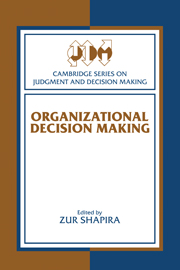Book contents
- Frontmatter
- Contents
- Series preface
- List of contributors
- Editor's preface
- Part I Introduction
- Part II Information processing and attention allocation
- Part III Preference processing
- Part IV Decision processes
- 9 The escalation of commitment: An update and appraisal
- 10 The possibility of distributed decision making
- 11 Aligning the residuals: Risk, return, responsibility, and authority
- 12 Organizational decision making as rule following
- Part V Alternative approaches
- Name index
- Subject index
11 - Aligning the residuals: Risk, return, responsibility, and authority
Published online by Cambridge University Press: 06 August 2010
- Frontmatter
- Contents
- Series preface
- List of contributors
- Editor's preface
- Part I Introduction
- Part II Information processing and attention allocation
- Part III Preference processing
- Part IV Decision processes
- 9 The escalation of commitment: An update and appraisal
- 10 The possibility of distributed decision making
- 11 Aligning the residuals: Risk, return, responsibility, and authority
- 12 Organizational decision making as rule following
- Part V Alternative approaches
- Name index
- Subject index
Summary
The notion of proper governance structures is strongly related to the idea of checks and balances. Such an idea is evident in the institutional structure of modern states where power is distributed among the legislative, executive, and judicial branches. In modern corporations the question of checks and balances is centered on control – that is, who has the authority to make decisions. Since business firms are operating under uncertainty, many of their decisions are risky choices that may lead to undesired outcomes.
Consider the case of Nicholas Leeson, whose risky future trading decisions led to the downfall of the 250-year-old Barings Bank. Although investigators can end up blaming other managers for the disaster, the question of governance should have been dealt with prior to the downfall. Indeed, due to the devastating consequences of Leeson's activities for the bank's shareholders, managers, and employees, this case also raises questions about the identification of the parties in whose interests modern firms are run and how they should be governed.
The Leeson case points at a major problem in corporate governance: Control was not aligned with risk. Such an alignment is a basic premise of a firm's decision-making process (Milgrom & Roberts, 1992). Those who stand to lose their investment should have control over risk-taking activities. Indeed, this was the basic premise of the entrepreneurial theory of the firm (see Coase, 1993, p. 59).
- Type
- Chapter
- Information
- Organizational Decision Making , pp. 238 - 256Publisher: Cambridge University PressPrint publication year: 1996
- 2
- Cited by



